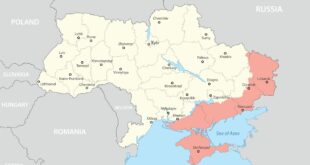“Red lines” have become a ubiquitous narrative of Russian-initiated conflict with the West. Putin repeatedly used “red lines” as a warning metaphor for the West, trying to establish his boundaries of international influence. The “red lines” acquired this warning connotation in his annual address to the Russian Federal Assembly on April 21, 2021, to be repeated several times later up to February 24, 2022. As explained by his press-secretary Dmitriy Peskov and many other Russian politicians and experts, “red lines’ relate to Russian national interests, outlining its national borders.
And not only Kremlin but the West also talks about “red lines”, though the West sees “red lines” in using nuclear weapons by Putin in his futile attempt to conquer Ukraine.
When addressing the nation on February 24, 2022, announcing an invasion of Ukraine, Putin said that any “interference” in Ukraine by outside powers would be “a red line” for Russia. However, the West started to support Ukraine long before the Russian invasion supplying Javelins and intelligence information. The West certainly interfered in different ways from the first day of the Russian invasion providing more weapons, ammunition, humanitarian aid, volunteers, anti-Russian information campaigns, sanctions, intelligence sharing, and military training, to name a few.
All Kremlin’s propaganda targets the inner audience first. When they speak to the West, at the same time, they address ordinary Russians. The apparent importance of “red lines” for the Kremlin, the ability to show that they are not violated, made the West artfully create information campaigns before supplying new deadly weaponry to Ukraine. These information campaigns aim to provide valid arguments for such supplies as a response to the escalation of the war from the Kremlin’s side. At the same time, they shift attention from the weaponry itself to “conflicts” inside the NATO countries around the supplies. They expose various technical problems, such as a lack of trained personnel to master new weaponry, no service maintenance base, and others. Finally, these information campaigns often highlight Kremlin’s atrocities against civilians (Bucha and missile bombing cities, villages, and critical infrastructure).
We have seen these tactics successfully employed more than once. The Kremlin’s loss of information war has become evident from the beginning of the war. However, when one talks about supplying Ukraine with modern tanks to fight against the Russian army, it takes one to be a master of information tactics to supply the tanks and not to break this crucial “red line.” For the last two decades, Putin has made the Victory of the USSR in the Greta Patriotic War (WW II in the Western tradition) the main achievement of recent Russian history, utilizing it as a unifying myth for multi-national Russia. This myth also serves as a justification for its aggressive foreign policy. Furthermore, this makes it very painful for Russia to think of fighting with foreign tanks, especially german tanks, making this red line very thick and visible.
Nevertheless, the West could dilute it without any seemingly essential consequences. Let’s see how it was done.
The German play: at first, Olaf Sholz, Chancellor of Germany, said that Germany would allow Leopard tanks to be sent to Ukraine only after US Abrams; this statement gets immediately refuted by the German Minister of Defense; the refutation followed by supporting statements in the US media that even go as far as saying that the German position irritates Washington.
The Polish play: first, Poland says that it can send a Leopard tank to Ukraine; then it refutes it; then Poland threatens that it would send the tanks even without Germany’s consent, to be followed by a statement of Germany’s Minister for Foreign Affairs that Germany would not block Poland sending tanks to Ukraine.
All these “conflicts and disaccords” happen before an official decision-making session in Rammstein format. Then the plays continued with Boris Pistorius, recently appointed Germany’s Minister of Defense, who, after the meeting at Rammstein, not only said that there were other countries besides Germany to disagree on shipping tanks to Ukraine (although he never revealed which ones), but also hinting later that the decision on tank shipping could be negative. In such a case, the decision would become irreversible. They even remembered a previous German Minister of Defense who allegedly refused to conduct an inventory of available Leopard tanks.
Less than five days later, a positive decision is taken, making it hard to believe that such significant disagreements and confusion could exist not only inside Germany’s government but also between leading European countries and the US. Of course, conflicts and disagreements might exist, and they do exist for different international topics. However, it is hard to imagine them being so publicly visible on such a vital issue as the Ukraine-Russia war. The war has been going on for almost a year now, and effective mechanisms of communication and decision-making must have been developed, at least in such an essential part of it as military aid.
After the war’s beginning, the West took a principal position in the war: to provide diverse support to Ukraine to fight against Russia. All sanctions and humanitarian and military aid issues get communicated, coordinated, and then agreed upon.
According to Francis Bacon’s famous quotation, knowledge is power; this power comes with information, and information comes with noise. The West utterly understands it employing this understanding with art and craft. And the Kremlin fails to play this game. Instead, this wonderful chaos of noise prior to any critical decision allows for diluting more and more “red lines.”
These information tactics allow the West to supply Ukraine with more deadly weapons. We will see another act of this information play before a decision to ship modern jet fighters to Ukraine is agreed upon. Then, of course, there will be the same level of “disagreements and conflicts,” but eventually, one shouldn’t doubt that Ukraine will get jet fighters, starting with Soviet MIG- and SU-fighters from Slovakia and Poland, then followed by F-16s and other NATO models.
The Kremlin’s reaction is precious. Putin’s press secretary, Dmitry Peskov, commented on the decision to ship tanks to Ukraine, saying that it became clear to the Kremlin that there was no accord in the West in general around the issue of military aid to Ukraine. Also, the fact that the West has enough modern tanks capable of fighting with Russian remains obscure for the Kremlin, according to Peskov. This is what the Russian propaganda wants and needs to see: disagreements and conflicts. This conflict’s agenda allows them to lullaby the Russian people with tales that the support for Ukraine will wither soon and that Russians need to be patient just a little bit more. Then Victory will come, exactly like in the Great Patriotic War.
The strategy of the West is clear; no Western country wants to be at war with Russia. At the same time, Ukraine needed support, so the West started supplying it with more advanced weapons. Now the supplies happen much quicker than at the beginning of the war. The “tank case” shows this change in the western approach to the weapon supply, where a silent embargo on offensive weaponry was in effect for 11 months.
The Kremlin’s narrative of “the red lines” failed from the beginning as Russia violated international “red lines” when it invaded a sovereign state. Furthermore, this ‘red line” is not only part of Western values but is one of the pillars of the system of International Law. Another pillar of international relations is that supplying weapons and even using one country’s experienced army officers to help another country’s army in its military actions has never been seen as direct involvement in a war. No one has seen, or described Soviet military support and presence in Vietnam against the U.S., or in Egypt and Syria against Israel as direct war between the U.S. and the USSR.
Putin’s several public warnings to respond if NATO crossed “red lines” by providing Ukraine with certain missile strike systems remained just words. Other prominent Russian officials repeatedly made similar warnings, promising to consider U.S. and NATO vehicles transporting weapons on Ukr
The West understands that Putin’s “red lines” are for the internal agenda only. Even the fact that they are not named but outline some obscure “national interests’, allows the Kremlin to interpret them differently, twisting its propaganda around. But the “red lines” do exist. The West should not underestimate them. Inability of the Kremlin to define and observe them. It is quite obvious that the next “red line” is national borders between and Ukraine and Russia as of Feb.24, 2022. This issue lacks accord in the West. Should Ukraine get Crimea back? Should it get it now or later? Should the West publicly announce its “red lines” outlining them as the Russian Federation’s borders as of 1991?
While these questions are still to be answered, one red line obviously exists for Putin. This line is his personal safety, and in the current power construction in Russia, Putin can secure his safety only if he retains power. When the West challenges his personal power, then he will feel the real threat. One should remember that it might be dangerous to corner a rat, especially one with a nuclear bomb. Putin’s body, ex-Russian President Dmitry Medvedev, regularly reminds us of that, saying that “a nuclear power can never lose a conventional war.” His regular remarks clearly state that the Kremlin acknowledges its possible defeat in Ukraine, but they also warn against such outcome. We should hope that Western leaders have learned how to play with Russia and will continue the winning game, weakening Russia further and successfully staying away from nuclear confrontation.
 Geostrategic Media Political Commentary, Analysis, Security, Defense
Geostrategic Media Political Commentary, Analysis, Security, Defense





